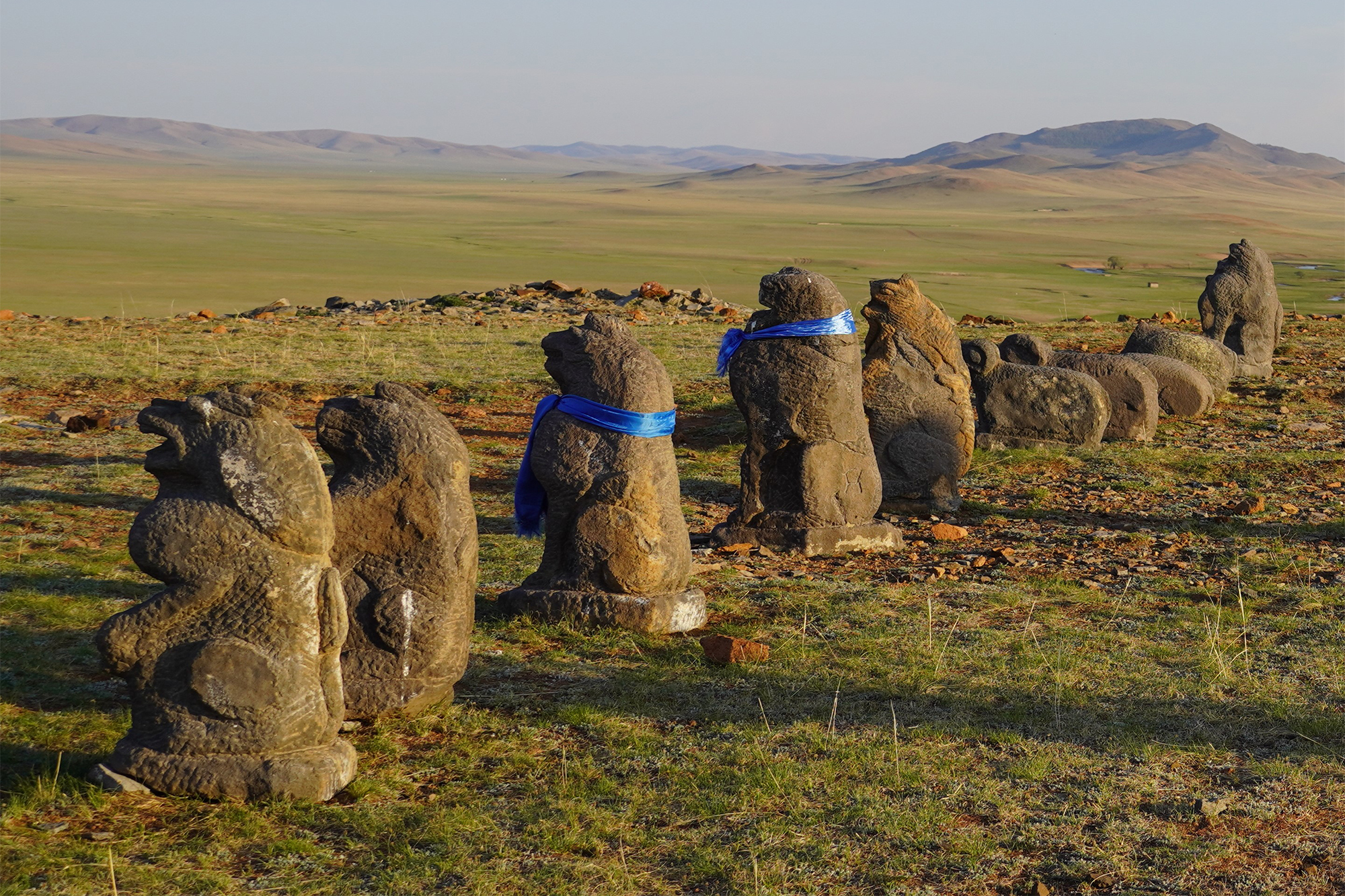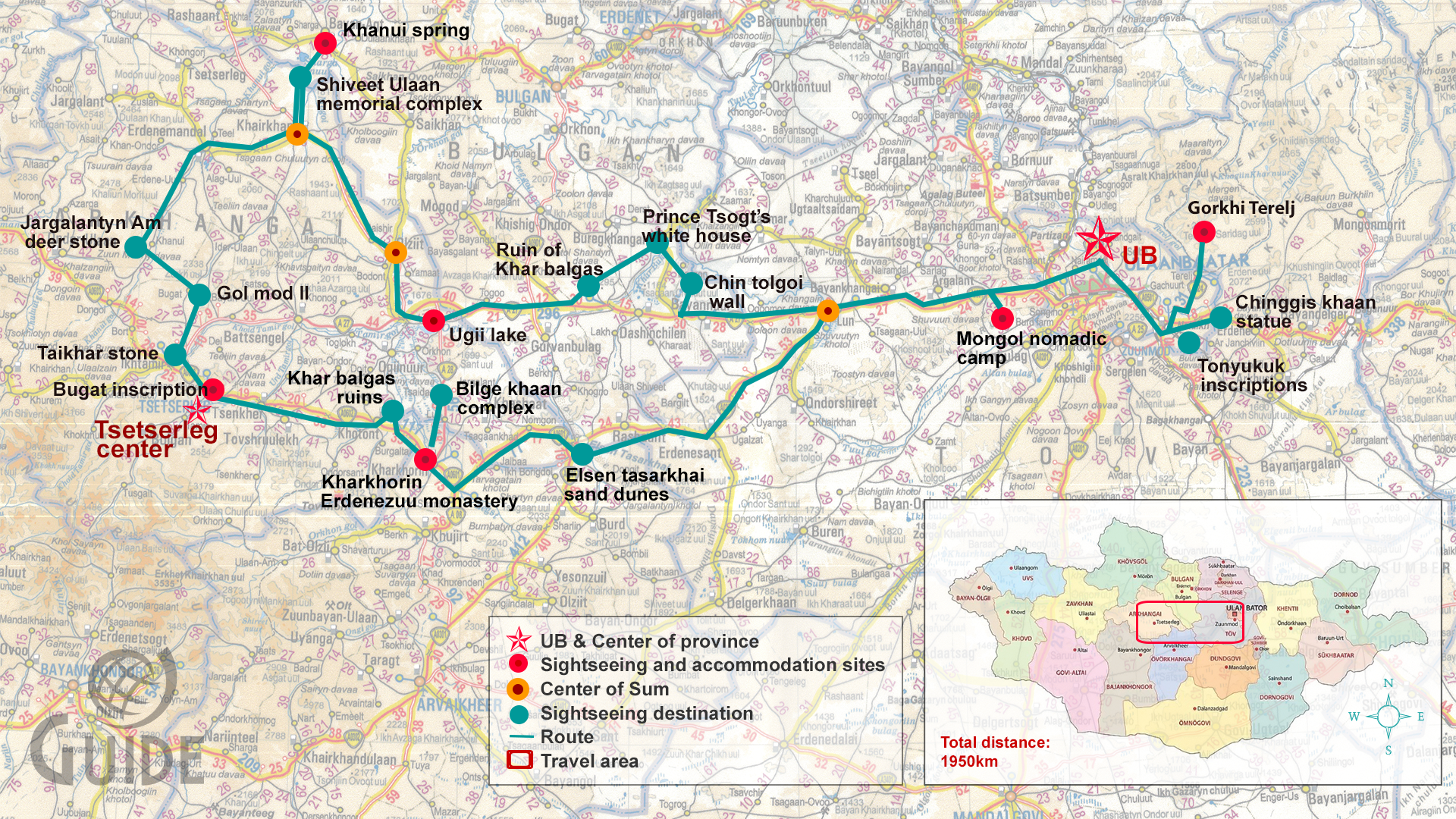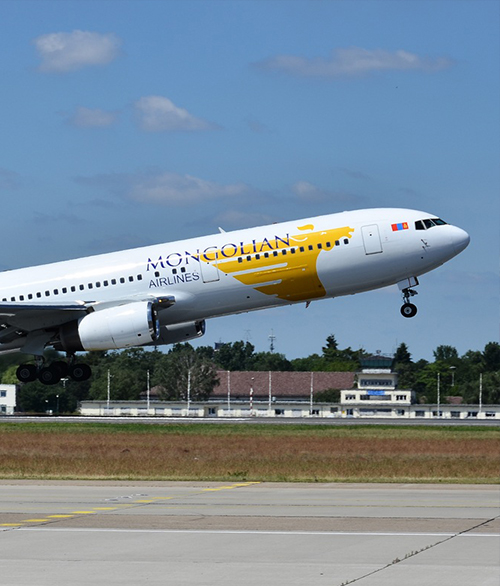Itinerary
DAY 1: Chinggis khaan airport – Ulaanbaatar (55 km)
You will be welcomed to Mongolia and start your holiday. Upon your arrival at Chinggis Khaan International Airport, our friendly team meet you at the airport and transfer you to a hotel. For the remainder of the day, you will be offered to take a city tour, including Chinggis Khaan Museum and Sukhbaatar square. The tour will be planned depending on your arrival time.
Meal: Lunch, Dinner
Accommodation: Hotel
DAY 2: Tonyukuk inscriptions – Terelj (180km)
This day, we visit the impressive Tonyukuk inscriptions in the Tuul river valley. This is a memorial complex consisting of the steles ofTonyukuk wise, who was the counselor to the last three successive khans (kings) of the Turkic khaganate, dominated between the 5th to 7th centuries in Central Asia. The inscriptions are about the Turk’s war stories, Tonyukuk’s praises, and words passed the to the next generation and the state of Turkic society at the time. After his death, his sacrificial shrine was built on the site. The admonitions, Tonyukuk wise told, have not lost their value until today and taught people the values to be "peaceful, orderly, honest, not to be bribed" etc. And our next stop of the day is the Chinggis Khaan Equestrian Statue, the 40 meters massive monument. Besides the statue, you will also visit the "small museum of history" in the basement building of the monument. Then, we head to Gorkhi-Terelj and take lunch in a tourist camp restaurant. Gorkhi-Terelj is the nearest and most famous tourist destination from Ulaanbaatar and the region is the southern end of the Siberian taiga. This is a beautiful nature area with sparse forests, mountain valleys, rocky cliffs, rivers, and streams. After lunch, we see the interesting rock formation Turtle Rock and arrive at the horse-hitching post and ride a horse leisurely. Before dinner, we travel back to Ulaanbaatar.
Meal: Breakfast, Lunch, Dinner
Accommodation: Hotel
DAY 3: Chin Tolgoin wall – Prince Tsogt’s white house – Ruin of Khar Bukh (420 km)
Early morning, we navigate 200km west from Ulaanbaatar and arrive at a small mountain hill, known as Chin Khairkhan. There, you will visit the medieval deserted town of Chintolgoin balgas. Now there we will see the ruins of the watchtower that was behind the town wall. From that plateau, you can see the surrounding of 20-30 km. In this area, researchers have discovered several roof pots with Kitan inscriptions and the remains of about 1,000 household stoves. Therefore, the site is identified as the remains of Kedun or Zhenzhou town of the 10th century. According to historical sources, twenty thousand soldiers from the northwestern province of Kitan stayed in Zhenzhou, and more than 700 Chinese and Jurchen families were exiled to the town. Then we travel 20km northeast from Chin Tolgoin balgas and arrive at Prince Tsogt’s white house. Prince Tsogt was a direct descendent of Chinghis khaan’s golden lineage and descendent to Ligden Khan, the last grand khan (king) of the Mongols. The house was formerly the castle of Queen Madai Taigal, the mother of Prince Tsogt, and her educational house. There we take a field lunch and continue our trip along the ancient city ruin, Khar Bukh Balgas, dating back to the Kitan age. Nowadays, the ruin covered an area of 500 square meters and the buildings of Khar Bukh were built with volcanic basalt, grindstone, and sedimentary rock beautifully stacked on top of each other. Before dinner, we will arrive at our next stop, Ugii lake and we stay in a tourist camp near it.
Meal: Breakfast, Lunch, Dinner
Accommodation: Tourist camp
DAY 4: Ugii Lake – Shiveet Ulaan memorial complex – Hanui Spring (200 km)
After breakfast, we visit the Ugii lake’s Information center. The lake covers 25 sq. km of an area with a length of 7 km and a width of 5 km and 15m at its deepest. As researchers found out, there are 14 species of fish, 27 species of floating plants, and 48 species of floating animals which included the Arctic Ocean ecosystem. Therefore, with its distinction, some 150 species of water birds gather along the lake. Then we drive to the small rocky hill named Shiveet Ulaan, located on the north side of the inflows of the rivers Hanui and Hunui in Bulgan province. On the way, we will have lunch at a small rural village. The memorial complex is devoted to Kutluk Khagan who belonged to the late Turkic Kaganate period. Alongside stone sculptures and stone statues, archaeologists also discovered statues of sheep and lions. From there, we see the remains of a complex of tombs and square tombs called artifacts of Tsagaan Olom and we reach the tourist camp next to the Hanui River Gorge. The Hanui River is a 420 km long river with many extinct volcanoes in its basin. As a consequence of that, healing hot springs are formed in canyons eroded by hot lava.
Meal: Breakfast, Lunch, Dinner
Accommodation: Spring camp
DAY 5: Jargalantyn Am site – Gol Mod II site – Taikhar stone (290 km)
As this day’s journey is the long one, we start driving early in the morning. We head to the Jargalantyn Am site, one of the largest deer stone ritual sites in existence in Mongolia, dating back to the VI-V century BC. The site has 28 deer stones and approximately 1400 ritual offering structures in the surrounding. It is believed that deer stone statues were built as the dedication of ritual making and sacrificing for the death of a tribal leader or military noble, dating back 5,000-3,000 years ago. A sacrificial structure is a stone structure under which horses and sheep are known to have been sacrificed for the deceased, and often their bones are found.
Our next stop is the Gol Mod II site, the funeral site of the Hunnu Empire (Xiongnu Empire). It is a site with about 570 graves dating back to 80-100 AD, and the researchers found that for one king's burial, there were accompanying 30-40 people buried together. Royal mausoleums are built in the form of a downward-facing pyramid, and the remains of the king were usually buried underground 15 meters deep inside a gold-covered wooden coffin. On the left side, accompanying graves were arranged in a row in the shape of a half-moon. Then we will go to see the Taikhar stone with Mongolian, Manchu, Chinese, and Tibetan inscriptions. It is an 18-meter-high stone and other than this stone, there are no rock formations around it.
Meal: Breakfast, Lunch, Dinner
Accommodation: Local hotel
DAY 6: Bugat inscription – Khar Balgas ruins – Kharkhorin (200 km)
On this day, in the center of Arkhangai province, you will visit an ethnic museum in a Buddhist temple house with a history of about 400 years. Also, you will see the oldest stele with Brahmi, the ancient Mongolian script, and Turkic runes writing. Then we travel to Khar Balgas ruins which was the capital of Uyghur Khaganate in the 7th - 8th centuries. Among of several cities were established during the Uyghur period, the Khar Balgas was located in the branch route of the Silk Road through Central Asia and played the role of trading center. We continue our journey to Kharkhorin, the ancient capital of Mongolian Empire. There, we visit the Kharkhorin Museum and get an idea of what the capital of the Mongol Empire was like. We explore the artefacts of Kharkhorin city brought out from underground by Mongolian and international scientists. After,we see the turtle stone statue that is an integral part of the history of Kharkhorin. Then you discover the heritage, culture, and history of Erdenezuu Monastery, built in 1586. Researchers believe that underground of this Erdenezuu monastery, there are the ruins of the royal palace with its remains of walled courtyard built by Ogodei Khan, son and the successor of Chingghis Khan.
Meal: Breakfast, Lunch, Dinner
Accommodation: Tourist camp
DAY 7: Bilge Khan Museum – Elsen tasarkhai (Sand dunes) – Mongolian Nomadic tourist camp (400 km)
Early morning, we depart for Bilge Khan complex. Bilge khan was the last king of the Turkic empire and ruled the empire for 19 years. He built this sacrifice complex and a temple of worship in 732 dedicated to his beloved brother, an intelligent and skillful general Kul Tigin who died unexpectedly in 731 at the age of 46. There is also a stele of Kul Tigin on the turtle stone base, which is engraved with a Turkic runic inscription with a total of 68 lines. Bilge Khan himself died in 734, and in 735, a sacrificial temple and a stele were built in his memory. In the museum of Bilge Khan, the artifacts and steles found in the ruins of the sacrificial temple of two brothers are displayed. From there, our next stop is Elsen Tasarkhai (Mongol Els dunes). We take lunch there and move to the Mongolian Nomadic Tourist camp which is located 55km from Ulaanbaatar and managed by nomadic herders.
Meal: Breakfast, Lunch, Dinner
Accommodation: Tourist camp
DAY 8: Mongolian Nomadic tourist camp – UB city (65 km)
After breakfast, we visit the herder family’s home, the traditional dwelling Ger. There you will learn more about the nomadic lifestyle, greeting culture, food, and clothing tradition, and simple furniture and appliances of Ger which suit nomadic life. Also, you will be guided to learn how to ride camels, horses, and yaks and you can take a short tour around. This nomadic tourist camp is highly recommended by tourists in recent years. After lunch, we arrive in UB city. We visit the Megjid Janraisag Temple in the Mongolian Buddhism center Gandantegchilen Monastery, the central square, and shopping centers. After dinner, you will spend a leisurely evening in the hotel.
Meal: Breakfast, Lunch, Dinner
Accommodation: Hotel
DAY 9: Belkh – Mountain Lake – Gobi factory (50 km)
This day, continue our journey in the early morning heading to Hunnu aristocratic tomb excavation located in the Belkh valley, north of UB city. Since 2021, a joint Mongolian-Hungarian scientists’ team is excavating, and at the present, they have discovered and excavated 3 noble graves. Then we arrive at the northern lifted part of UB city where is a place known as "Mountain Lake". It is a historical place of UB where the main construction stones were prepared during the establishment of the city. The entire UB city can be seen from that highland. Also, there we will know about shaman culture and meet with a shaman. If you want, you can ask the shaman about your life and job, etc. After lunch, we go to the Gobi factory brand store and you may shop for fashionable pieces of cashmere.
Meal: Breakfast, Lunch, Dinner
Accommodation: Hotel
DAY 10: Ulaanbaatar - Chinggis khaan airport (55 km)
We transfer our travelers to the airport according to the departure schedule. Travelers take a return flight to the respective country from the Chinggis Khaan International Airport.
Meal: Breakfast







